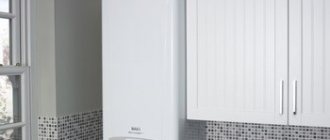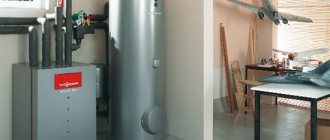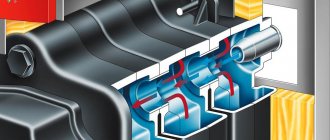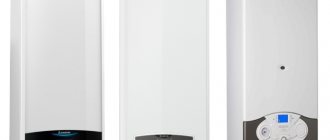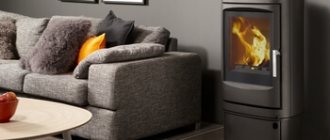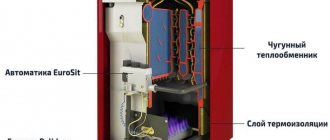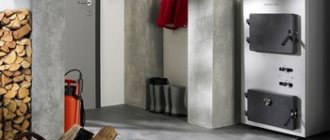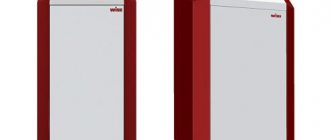How to choose a gas boiler?
First of all, you must decide where it will stand. Some models require the construction of a special chimney, and such a project is difficult to coordinate. If a full-fledged heating unit cannot be installed in a room, parapet devices come to the rescue.
They do not require a vertical chimney and are often independent of power supply.
We have compiled a rating for 2021-2022 of the best parapet gas boilers presented on the Russian market in terms of price/quality ratio. When compiling the list, we were guided by functionality, ease of installation and operation, as well as customer reviews.
In our rating you will find only market leaders!
What are parapet gas boilers?
A parapet gas boiler is a compact boiler unit used for heating (single-circuit) and supplying objects with hot water (double-circuit).
In general, such models were initially developed as a non-volatile alternative to wall-mounted devices, but unlike the latter, they are universal when choosing a place for installation, i.e. they can be placed either wall-mounted or floor-mounted. The only condition is that it must be secured to the outer wall of the room, preferably below the line of the window sills.
Design and principle of operation of the equipment
In terms of functionality, parapet gas boilers are something between a classic atmospheric heat generator and an air convector.
This combination is achieved by modifying standard units:
- closed combustion chamber - completely isolated from the living space, which eliminates any influence of smoke products on the internal microclimate;
- primary heat exchanger - has dissipative turbulators that increase the passage time of air flows and prevent heat from evaporating;
- air intake and smoke removal system - implemented through a short (from 25 cm to 53 cm) coaxial pipe, without complex elbows, wiring and insulation;
- sealed steel housing - equipped with a viewing window for direct visibility of the burner flame, as well as convection holes, the so-called. ribs.
Schematic representation of the design and operating principle of parapet models.
The operating principle of parapet boilers is not entirely typical: despite the closed combustion chamber, they operate according to a natural air exchange (draft) scheme - street oxygen is supplied through the outer part of the pipe from below to the burner that heats the heat exchanger, after which the smoke is removed through the core of the pipe.
In the room itself, there is also a continuous circulation of air: passing through the ribs, it heats up and, increasing in volume, displaces the cold mass. Thus, if you choose the characteristics of the boiler correctly, it will be sufficient not only to heat the heating circuit, but also to heat the space around it (without a radiator).
Under what conditions is it most advisable to use such boilers?
Parapet models are used to organize heating and hot water supply (DHW) systems in buildings whose design does not involve the construction of a full-fledged chimney, as well as with problems in power supply and other aspects: stable pressure, soft water and high-quality fuel.
However, it is necessary to take into account the power limitation in the range from 4 to 46 kW, i.e., in terms of similar indicators, “parapets” are seriously inferior to both wall-mounted and, even more so, floor-standing units. This means that it is reasonable to install them only in relatively small rooms (from 30 to 250 m2), such as private and country houses, retail sites, offices in shopping centers and, of course, high-rise apartments, in which they fit perfectly into the niche under the windowsill in the kitchen.
How to choose a room thermostat and save up to 30% per month on heating
Possibility of installing a parapet boiler in a wooden house
Almost any wooden house can be equipped with a parapet boiler: the exception is barracks and other old-style apartment buildings.
Installation is carried out according to the current SNiP rules 42-101-2003:
- the unit is placed on an external wall, while an empty gap should remain outside - from 0.3 to 3.1 m (depending on the power), without facade elements;
- The chimney outlet must not be installed near or directly in enclosed spaces (entry, attics, entrances, balconies, loggias, etc.);
- the mounting wall is sheathed with fire-resistant material and covered with a sheet of steel so that there is a distance of 10–25 cm to difficult and easily flammable areas;
In wooden houses, internal and external thermal insulation of a coaxial chimney is mandatory - porous wood, in order to increase fire safety, is prepared in advance for overlapping, treated with special mastics and impregnations in 2-3 layers.
Many companies still use asbestos to protect walls from fire, although today it is officially recognized as a material hazardous to health. Ceramic or silicate bricks, GVP-slabs, mineral wool, basalt insulation, foam and aerated concrete panels, and even gypsum plaster can help replace it.
Principle of operation
Parapet boilers have a closed combustion chamber, which completely prevents combustion products from entering the room.
Smoke removal and air intake are carried out through a coaxial chimney, consisting of two pipes of different diameters.
Street oxygen enters through a large external pipe according to the principle of natural air exchange (draft). It maintains the flame of the main burner, which heats the heat exchanger. The smaller one, the exhaust core, serves to release combustion products to the outside.
The heat exchanger is equipped with dissipative turbulators . They slow down the flow of air and prevent heat from escaping. The boiler body has convection holes. Thanks to them, the parapet device can be used as a heating radiator.
Reviews of domestic parapet boilers: advantages and disadvantages
Despite the fact that such units are still new to most people, there are users who have already tried them and formed their own opinion.
Common reviews from owners of parapet gas boilers:
| Advantages | Flaws |
| budget price - finding an option to suit every taste and budget is not difficult, since prices start from 10,000 rubles | manual control - ignition (piezo) and mode change (mechanical control) is possible only with human participation |
| freedom of communication - versatile connection of pipes reduces the cost of piping the unit and simplifies installation | meager automation - the set consists of a thermocouple that regulates the position of the gas valve and one thermostat |
| replacement of radiators - the holes in the casing themselves provide a good flow of heat, which means that the batteries in the room in which the boiler is installed can be removed | dependence on the weather - if a wind protection is not installed on the chimney, it often happens that the flame simply goes out due to the wind |
| energy independence - almost all models do not require power, but there are also universal ones that work “according to the situation” | inserting a chimney - to remove the pipe you will have to punch a hole in the wall, which is not allowed to be done in all houses |
In connection with the last drawback, one cannot help but note the likelihood of social difficulties also arising: there is no need to formally coordinate the installation with neighbors if technical parameters are observed, but they are unlikely to be happy with the release of carbon monoxide at the level of their windows, because this is also worth thinking about in advance .
What is the difference from the usual?
The main difference between parapet models and conventional boilers is the ability to obtain increased safety from a non-volatile design and no impact on the internal atmosphere of residential premises.
If a conventional atmospheric boiler consumes ambient air, actively burning oxygen and requiring constant ventilation, then parapet models are completely separate and do not disturb the air exchange regime.
Another difference is the ability to independently heat air, making a parapet boiler similar to a stove.
How to calculate the minimum required power
In most cases, to determine power (Q), a simplified formula is used, where 1 * kW of thermal energy is taken per 10 m2 of heated area.
- *approximate heat loss of a brick building with ceilings of 2.7 m from the central climatic zone of Russia.
For example, for a residential building of 120 m2 located in the Moscow region, the minimum required power of a parapet gas boiler will be Q=120÷10×1=12 kW.
We also recommend making a reserve of 15–20% of the power so as not to operate the heat generator at its limit for a long time, i.e. for the same object Q≈14–15 kW. Also, if we are talking about a double-circuit model, then you will have to add about 15–20% more to provide hot water supply, the total result will be Q≈16–17 kW.
In an apartment of 120 m2 (not corner), heat loss is a priori 10–15% less, so for a unit with one circuit Q≈12.5–13 kW, with two circuits Q≈14.5–15 kW.
How to accurately calculate the required boiler power Individual calculation, formula and correction factors
Reviews
Taiga Zh7-KS-GVS-10 S: Victor E., Pskov
We decided to install autonomous heating in the apartment. This model attracted us with its price—16,000 rubles—and its promised capabilities. It does not need a traditional chimney - gases are discharged through a coaxial pipe. It works very quietly - almost silently, soot does not accumulate in the chamber. It heats the water well - we have a dual-circuit version, you can wash comfortably without interruptions in temperature.
AKGV-12S Alaska: Boris T., Vologda
We wanted to take an inexpensive and efficient boiler that would simultaneously heat water for washing and other things, so we settled on a Russian brand. Today, gas is not so expensive that it is worth spending money on imported devices that promise savings. We are almost satisfied with our “Alaska” - the house is warm, since the power was chosen with a reserve, the water heats well. True, it only works for one season; we’ll see what problems there will be next.
Termotechnik brand boilers can be a profitable investment in heating if you choose the right model and provide it with timely maintenance. The products of the Rostov plant are reliable, easy to use and attract consumers with their moderate cost.
The best known manufacturers and models: characteristics and prices
Lemax Patriot-12.5
This unit can be briefly described in two words – simplicity and efficiency. Despite the fact that the heat exchanger is made of ordinary steel, thanks to its coating with anti-corrosion enamel and an inhibitory composition, it is less susceptible to aggressive substances: acids, salts and mineral oils and can last 12-15 years.
With a power of 12.5 kW, its fuel consumption will be no more than 0.75 m3, which is one of the best indicators. But the “picture” is spoiled by a rather clumsy rectangular-shaped case and an uninformative control system: of the devices for monitoring current parameters, only a thermometer is included “by default.”
Manufacturer: LEMAX (LEMAX), Russia.
Floor-standing gas boilers The most detailed selection instructions and the best models
ATON Compact-12.5EB
A relatively multifunctional boiler with a power of 12.5 kW is distinguished by its modest dimensions, which is not inherent in every double-circuit analogue: for flow-through heating it uses an S-shaped coil made of copper - a metal more resistant to corrosion and with increased thermal conductivity, serving up to 17 years .
The hot water supply rate t 35±5 °C can reach 5–6 l/min, while fuel consumption will not exceed 1.53 m3/h. The convenience of installation work will allow you to appreciate the model even more - versatile outputs allow you to connect it on both the right and left sides.
Cost: 23,350 – 27,500 rubles.
Manufacturer: ATON (ATON), Ukraine.
TERMOMAX S-12E
Another unit, devoid of any hints of design. Despite this circumstance, you should not write it off, because the lack of external attractiveness is compensated by economy, efficiency and real comfort of operation: the main control elements are located directly on the front of the outer panel.
On request, the boiler can be supplemented with an expansion tank and a circular pump (not included in the basic package), which will make it suitable for connection to complex heating systems, including those with high hydraulic resistance. Maximum gas consumption at a power of 12.0 kW is 1.39 m3/h.
Cost: 15,860 – 20,340 rubles.
Manufacturer: TERMOMAX (TERMOMAX), Ukraine.
Hephaestus VPR KSG-10S
Perhaps this option is one of the best parapet gas boilers for heating a private home: it is clear, almost silent (distinctively quiet at start-up) and quite highly efficient, given the ability to operate in the “small flame” mode, which allows reducing the average gas consumption to 0.60 m3/h.
Despite the fact that the unit itself has a Russian-made assembly, it contains the well-known Italian automation of the “SIT” type, which, based on the current heat losses, maintains an optimal power level (within 10 kW), as well as a slot burner of the “BRAY” type , which does not require air flow adjustment.
Cost: 19,680 – 23,840 rubles.
Manufacturer: Gefest WPR (Hephaestus VPR), Russia.
Device
The main advantage of any domestic gas equipment is its affordable prices; in addition, it is easy to find spare parts for it. Russian boilers outperform imported ones in terms of adaptation to local conditions. Many European heaters cannot withstand the harsh climatic conditions and peculiarities of gas and water supply in Russia.
Termotechnik boilers have a standard design typical of classic atmospheric and turbocharged units. They do not have any special features: gas is supplied to the burner, which, when burned, releases thermal energy to the heat exchanger. The latter heats the coolant, which, continuously circulating, distributes heat throughout the heating system.
Computerized automation controls all processes: it takes readings from sensors and, based on the information received, adjusts the operation of the system.
Main characteristics
The parameters of gas heaters are inferior to their European counterparts, but for domestic consumption their characteristics are excellent:
- operate on natural gas or propane-butane;
- nominal water pressure - 0.85 MPa;
- thermal insulation 10 cm thick;
- The minimum coolant temperature in operating mode is 60 °C. If it is lower, it means the heater is faulty.
How to choose
Understanding the wide range of boilers presented is not easy. The primary factors that the consumer must take into account are the climatic conditions of the area and the heated area. When choosing a suitable option, you must first pay attention to:
- thermal power;
- efficiency;
- gas consumption;
- cost and dimensions.
The consumer also needs to decide:
- with installation type - floor or parapet;
- with the number of circuits - one or two. Double-circuit versions not only heat homes, but also heat water for domestic use.
Prices: summary table
Rating of the most popular models of parapet gas boilers:
| Model name | DHW, l/min | power, kWt | Efficiency, % | Flow, m3/h | price, rub. |
| LEMAX Patriot-12.5 | —— | 12,5 | 87 | 0,75 | 21 500 |
| ATON Compact-12.5EB | 5–6 | 12,5 | 90 | 1,53 | 25 000 |
| TERMO MAX C-12E | —— | 12,0 | 90 | 1,39 | 18 000 |
| Hephaestus VPR KSG-10S | —— | 10,0 | 92 | 0,60 | 21 500 |
The best foreign floor-standing single-circuit boilers
Let's look at the most popular models from Western manufacturers:
Protherm Wolf 16 KSO
The brainchild of Slovak engineers, the Volk 16 KSO floor-standing boiler is designed for heating medium-sized private houses. With a power of 16 kW it can heat 160 sq. m.
Main characteristics:
- Efficiency - 92.5%;
- coolant temperature - 80°;
- heating system pressure (max) - 1 Bar;
- fuel consumption - 2.4 m3/hour;
- dimensions - 390x745x460 mm;
- weight - 46.5 kg.
The unit is non-volatile, which is not typical for European models - they prefer fully functional designs. In addition, it is equipped with a two-pass heat exchanger, which increases the performance of the unit.
BAXI SLIM 1.230 iN
Italian boiler from a famous European manufacturer. Its power is 22.1 kW, designed to operate in a room of 220 sq.m.
Boiler characteristics:
- Efficiency - 90.2%;
- coolant temperature - 85°;
- heating system pressure (max) - 3 Bar;
- fuel consumption - 2.59 m3/hour;
- dimensions - 350x850x600 mm;
- weight - 103 kg.
The heat exchanger of this boiler is made of ductile cast iron, the warranty period is 2 years.
MORA-TOP SA 20 G
Czech engineers offer users a 15 kW boiler capable of heating 150 square meters. m. area. A cast iron heat exchanger stabilizes the operation of the system and equalizes the temperature, eliminating sudden jumps.
Boiler parameters:
- Efficiency - 92%;
- coolant temperature - 85°;
- heating system pressure (max) - 3 Bar;
- fuel consumption - 1.6 m3/hour;
- dimensions - 365x845x525 mm;
- weight - 99 kg.
An additional advantage is the non-volatile design, which expands the capabilities of the unit in difficult conditions.
MORA-TOP SA 60
Another Czech boiler with a capacity of 49.9 kW. Suitable for heating a house of 500 square meters. m., as well as for public or commercial premises.
Unit characteristics:
- Efficiency - 92%;
- coolant temperature - 85°;
- heating system pressure (max) - 3 Bar;
- fuel consumption - 5.8 m3/hour;
- dimensions - 700x845x525 mm;
- weight - 208 kg.
The boiler is equipped with a cast iron heat exchanger consisting of 7 sections. Electronic controls provide constant control over the operating mode of the system.
Protherm Bear 40 KLOM
Slovak floor-standing unit with a power of 35 kW. Heating area - 350 sq. m.
- Efficiency - 90%;
- coolant temperature - 85°;
- heating system pressure (max) - 4 Bar;
- fuel consumption - 4.1 m3/hour;
- dimensions - 505x880x600 mm;
- weight - 130 kg.
The features of the boiler include the design of the heat exchanger - it is a cast iron two-pass unit of 5 sections.
Why does the boiler blow out in the wind and what to do in this case?
Blowing out may indicate a failure in the connection of the chimney and automation; more often it indicates a lack of wind protection on the head. However, in general, blowing out the burner flame by the wind is a significant and most well-known problem with parapets, which is why they never gained super popularity.
As a rule, the casing of a coaxial chimney, manufactured in a factory, already has a special insert that protects against gusts of wind. If it is not included in the kit, then you will have to look for a suitable deflector or make it yourself: give a sheet of galvanized steel the desired shape, and then attach it to the head with press washers or rivets.
Factory wind protection and an example of a homemade solution by the owners.
When the boiler still goes out after installing the protection, there is no point in doing anything further: you can, of course, continue to install new heads and deflectors, add bends to the coaxial pipe, or install a vertical chimney, but then the whole point of installing a parapet model will be lost.
How to prepare the boiler for operation
The detailed instructions that come with each model will help answer most questions that arise during the operation of equipment from Termotechnik. Reading the manual is useful for every owner to avoid mistakes and breakdowns.
It is especially important to read the instructions before diagnosing or repairing. For example: the burner goes out and it is impossible to immediately determine why this is happening - there can be about a dozen reasons for such a problem.
Before turning on the boiler, you must fulfill all the manufacturer's requirements regarding the premises used for installing the equipment. You also need to properly connect and configure the device.
All installation and adjustment work must be performed by specialists who have a special permit to perform the work. The first ignition is carried out after completion of installation and piping. Be sure to check whether the equipment is installed correctly. It is necessary to ensure that all fastenings comply with fire safety regulations.
It is prohibited to place flammable materials near heaters. It is prohibited to place gas appliances near windows - this will interfere with their operation. When installing equipment, you need to pay attention to the body - it must stand level, distortions are unacceptable.
When the equipment is installed, you need to connect cold water to it by removing the plugs from the pipes. Filters are installed at the inlet to prevent dirt particles from entering the system. Ball valves must be installed on each branch pipe used for piping. It is especially important to install gas pipes correctly - you should not do this yourself, invite a specialist.
Premises requirements
The room intended for installation of Termotechnik heaters must have a constant flow of air. The room is equipped with a ventilation hood.
Gas appliances can only be mounted near non-flammable walls, retreating 15 cm from them. Non-flammable walls must be covered with steel sheets - they are attached to asbestos sheets, the thickness of which is 5 mm. The dimensions of the sheet should be 10 cm larger than that of the heater. The passage in front of the facade should be more than one meter.
If the heater is mounted on a wooden floor, first lay the asbestos sheet, and then the metal one.
Where to buy a parapet gas boiler for heating a private house or apartment
In Moscow and Moscow Region
- MirCli (mircli.ru/search?keyword=parapet+gas+boiler+heating) – Leningradsky Ave. 80, building G, tel. +7 (863) 303–35–06, +7 (800) 775–29–90.
- ProComfort (pro-komfort.com/kotly-otopleniia/parapetnye-gazovye) – 1st Vyazovsky Prospect, 4, building 19, tel. +7 (800) 333–56–02, +7 (863) 333–26–06.
In St. Petersburg
- ThermoMIR (thermomir.ru/parapetnye_gazovye_kotly_rossijskogo_proizvodstva) – st. Lensoveta building 62, building 1, tel. +7 (812) 615–80–19, +7 (800) 500–47–02.
- TeploDvor (ru/kotly-otoplenija/napolnye-gazovye-kotly/parapetnye) – Vitebsky Ave. 3/B, office 25, tel. +7 (812) 628–13–33, +7 (800) 775–21–95.
And in conclusion, I would like to clarify that such boilers are not yet a full replacement for either wall-mounted or floor-standing units. In fact, in the desire to “embrace the immensity,” manufacturers take half measures, cutting back on certain parameters. Personally, we recommend taking a familiar, but more reliable and effective analogue.
Gas boilersParapet boilers
Advantages and disadvantages
The positive features of gas appliances from Conord can be determined according to the reviews of those owners who actively use them:
- large model range;
- models have 3 types of automation;
- efficiency;
- high efficiency;
- in the event of a boiler breakdown, you can find spare parts quite quickly;
- good thermal insulation;
- guarantee of flawless operation for 3 years;
- uninterrupted operation for almost 15 years;
- steel heat exchangers help withstand thermal deformations;
- the use of water from the water supply system as a coolant;
- the ability to connect to a system with various types of circulation of the working environment;
- almost complete absence of wall-mounted appliances;
- energy independence of devices;
- use in certain series of automation parts made in Italy and Poland;
- simplified process of using the device.
Boilers from this manufacturer are created in accordance with the characteristics of the domestic climate and are designed to generate the required amount of heat to warm the home even in the most severe frosts.
The reliability of these popular devices is guaranteed by the increased level of durability of heating devices, and their independence from electricity will allow them to function without any failures or delays, especially in conditions where there is no electricity.
The low level of noise impact during operation, compact size and stylish design will allow you to place the device in the kitchen or any other room without harming the design of this room.
A gas unit with 2 circuits from Conord can heat the room as quickly as possible, and also provide home owners with heated water for personal needs.
The safe operation of the products is guaranteed by the arrangement of various protection components of the automation box, which will help turn off the product when the traction is lost. In addition, the boiler will be turned off in the event of any breakdown or any other type of failure. You will be able to automatically adjust the heating temperature of the device, and if the fuel pressure level is too low, the device will provide rapid forced air injection to maintain the functionality of the device.
Disadvantages of Conord products:
- not the highest build quality of some models;
- the steel thickness will be no more than 3 mm;
- ban on the use of antifreeze.
Types of equipment by power
The Ross parapet boiler can have different capacities. The quality of heating and the efficiency of using the unit will depend on the choice of the model with the most suitable power. This is due to the fact that if the power is higher than necessary, then electricity and gas will be wasted. Quite often it is recommended to use a formula that involves choosing equipment based on one kilowatt per 10 square meters. In fact, this calculation cannot be called correct, since the indicator is averaged. In practice it does not correspond to reality. When calculating, which provides for 1 kilowatt per 10 square meters, the difference between a house and an apartment is not taken into account. It is important to take into account the number of openings, ceiling height, wall material and other parameters that make up the level of thermal insulation. Experts recommend doubling this formula, using 2 kilowatts per 10 square meters. This will allow you to get a margin that takes into account possible drafts, high ceilings, thin walls and an excessive number of windows.
The Dani parapet boiler, like other models of similar equipment, is economical, low cost and easy to operate. It can perform the functions of a water heater and does not require the installation of an additional heating network, since it is a convector and a stove at the same time. Each master can easily connect such a unit independently, without resorting to the help of specialists. Double-circuit parapet boilers are modern, convenient heating devices that can be installed in any type of premises, for example, apartments or private houses, garages and outbuildings.
Disadvantages of parapet boiler structures
- Low power (no more than 40 kW) does not allow heating industrial-scale premises;
- When installing a coaxial pipe, you need the help of a specialist;
- In the absence of a pump for forced water supply in the system, it is desirable for better circulation that the boiler be the lowest point in the heating system.
Weighing the pros and cons of parapet boilers Termotechnik
, we can conclude that this is the best option in many respects: safety, ergonomics, cost, design.
Still have questions? Just call or write to us - the specialists of the online store mnogovann.ru
will help you make your choice and give full consultation.
recommended products
Gas parapet boiler “Termotechnik” AOGV-7S Leader
17000 ₽
Gas parapet boiler "Termotechnik" AOGV-10S Leader
18000 ₽
Gas parapet boiler "Termotechnik" AOGV-12S Leader
20200 ₽
Gas parapet boiler "Termotechnik" AOGV-16S Leader
20400 ₽
Gas parapet boiler “Termotechnik” AKGV-7S Leader (with water)
19900 ₽
Gas parapet boiler "Termotechnik" AKGV-10S Leader (with water)
21300 ₽
Gas parapet boiler "Termotechnik" AKGV-12S Leader (with water)
23800 ₽
Types of boilers by functionality
Parapet boilers can have one or two circuits, in the first case only the home is heated, in the second the house is provided with hot water. They are complemented by a flow-through heater, which is usually copper. This material has the best thermal conductivity. Such a unit can be connected to the system both on the right and on the left, or on both sides, thanks to which heating wiring is simplified. This appeals to the modern consumer, who is increasingly choosing parapet boilers.
Advantages
Positive aspects are guaranteed in each case if you manage to choose a suitable model taking into account its characteristics.
- It is assumed that parapet gas boilers can be used indoors, regardless of their purpose. Moreover, the creation of additional structures is not necessary.
- The price is expected to be affordable compared to other gas boilers.
- Compact dimensions make it easier to find a place for installation.
- Installation activities are extremely easy.
- Design features allow the use of a parapet boiler without additional heating radiators. The boiler is capable of being a functional heater, and this requires convection holes.
- High level of functionality.
- Various power options.

